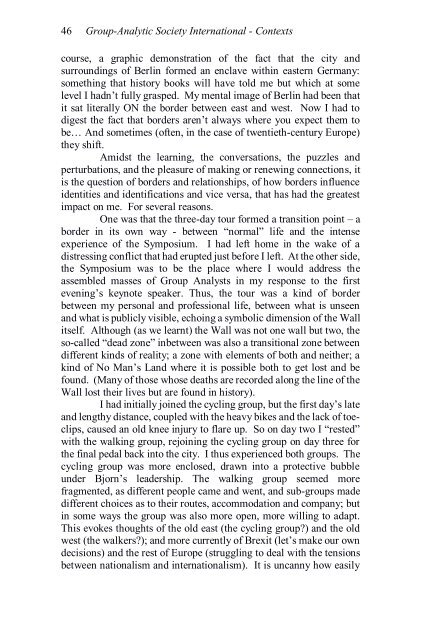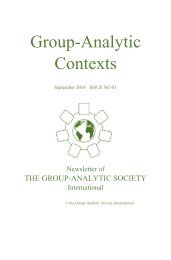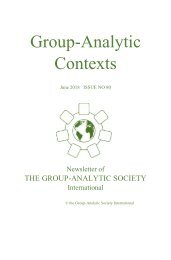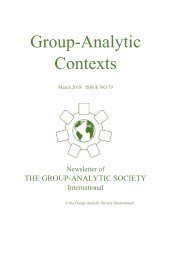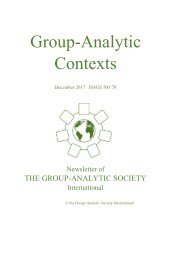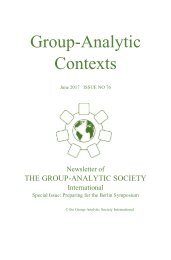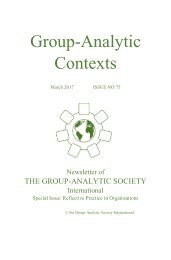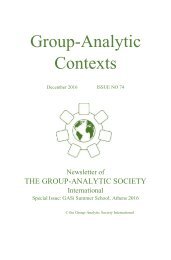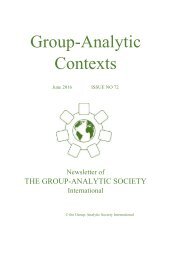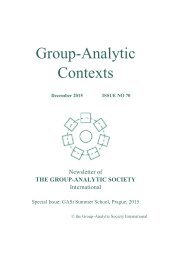Group Analytic Contexts, Issue 77, September 2017
Newsletter of the Group Analytic Society International
Newsletter of the Group Analytic Society International
You also want an ePaper? Increase the reach of your titles
YUMPU automatically turns print PDFs into web optimized ePapers that Google loves.
46 <strong>Group</strong>-<strong>Analytic</strong> Society International - <strong>Contexts</strong><br />
course, a graphic demonstration of the fact that the city and<br />
surroundings of Berlin formed an enclave within eastern Germany:<br />
something that history books will have told me but which at some<br />
level I hadn’t fully grasped. My mental image of Berlin had been that<br />
it sat literally ON the border between east and west. Now I had to<br />
digest the fact that borders aren’t always where you expect them to<br />
be… And sometimes (often, in the case of twentieth-century Europe)<br />
they shift.<br />
Amidst the learning, the conversations, the puzzles and<br />
perturbations, and the pleasure of making or renewing connections, it<br />
is the question of borders and relationships, of how borders influence<br />
identities and identifications and vice versa, that has had the greatest<br />
impact on me. For several reasons.<br />
One was that the three-day tour formed a transition point – a<br />
border in its own way - between “normal” life and the intense<br />
experience of the Symposium. I had left home in the wake of a<br />
distressing conflict that had erupted just before I left. At the other side,<br />
the Symposium was to be the place where I would address the<br />
assembled masses of <strong>Group</strong> Analysts in my response to the first<br />
evening’s keynote speaker. Thus, the tour was a kind of border<br />
between my personal and professional life, between what is unseen<br />
and what is publicly visible, echoing a symbolic dimension of the Wall<br />
itself. Although (as we learnt) the Wall was not one wall but two, the<br />
so-called “dead zone” inbetween was also a transitional zone between<br />
different kinds of reality; a zone with elements of both and neither; a<br />
kind of No Man’s Land where it is possible both to get lost and be<br />
found. (Many of those whose deaths are recorded along the line of the<br />
Wall lost their lives but are found in history).<br />
I had initially joined the cycling group, but the first day’s late<br />
and lengthy distance, coupled with the heavy bikes and the lack of toeclips,<br />
caused an old knee injury to flare up. So on day two I “rested”<br />
with the walking group, rejoining the cycling group on day three for<br />
the final pedal back into the city. I thus experienced both groups. The<br />
cycling group was more enclosed, drawn into a protective bubble<br />
under Bjorn’s leadership. The walking group seemed more<br />
fragmented, as different people came and went, and sub-groups made<br />
different choices as to their routes, accommodation and company; but<br />
in some ways the group was also more open, more willing to adapt.<br />
This evokes thoughts of the old east (the cycling group?) and the old<br />
west (the walkers?); and more currently of Brexit (let’s make our own<br />
decisions) and the rest of Europe (struggling to deal with the tensions<br />
between nationalism and internationalism). It is uncanny how easily


